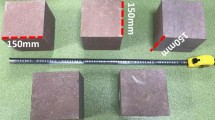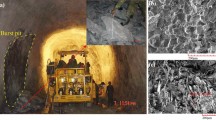Abstract
The fast unloading delayed rockburst experiments on single-side, double-side, three-side, and four-side were carried out using the self-developed true triaxial rockburst experimental apparatus, which can realize the fast unloading of multiple loading surfaces in the horizontal direction under high stress. The rockburst experiment’s stress–strain curve, energy evolution, failure characteristics, and acoustic emission (AE) characteristics are investigated. The results show that the rockburst gradually reduces the axial peak stress and strain when increasing the number of unloading surfaces (NUS). The rise in the axial strain at the fast unloading point will progressively grow when the NUS increases, indicating that the sample’s expansion in the unloading direction will gradually increase. Fast unloading causes unloading damage, which causes a sudden rise in dissipated energy at the unloading point. The total energy and elastic strain energy input by axial stress at the bursting point gradually declines when the NUS increases, but the dissipated energy increases. The release rate of elastic strain energy at the bursting point increases when the NUS increases, and the rockburst becomes more intense. The abrupt value of the cumulative AE hits at the fast unloading point and the cumulative AE hits at the burst point increase with the NUS increase. The changing trend of the multifractal parameter, which initially decreases and then rises abruptly, can be regarded as the precursor of rockburst. The hysteresis of the precursor of rockburst grows when the NUS increases.
Highlights
-
The fast unloading delayed rockburst tests on single-side, double-side, three-side, and four-side were carried out using the self-developed true triaxial rockburst experimental apparatus.
-
Energy analysis and high-speed recording of the rockburst process found that the severity of the rockburst does not depend on the amount of elastic strain energy stored in the rock sample but rather on the release rate of energy at the rockburst point.
-
The changing trend of the multifractal parameter, which initially decreases and then rises abruptly, can be regarded as the precursor of rockburst. The hysteresis of the precursor of rockburst grows when the NUS increases.


















Similar content being viewed by others
Data availability
Data generated or analyzed during this study are available from the corresponding author upon reasonable request.
References
Akdag S, Karakus M, Taheri A (2018) Effects of thermal damage on strain burst mechanism for brittle rocks under true-triaxial loading conditions. Rock Mech Rock Eng 51(6):1657–1682
Bruning T, Karakus M, Akdag S (2018) Influence of deviatoric stress on rockburst occurrence: an experimental study. Int J Min Sci Technol 28(5):763–766
Cai MF, Wang J, Wang S (2001) Prediction of rock burst with deep mining excavation in Linglong gold mine. Int J Min Met Mater 8(4):241–243
Chen ZY, Su GS, Ju J (2019) Experimental study on energy dissipation of fragments during rockburst. B Eng Geol Environ 78(7):5369–5386
Cook NGW (1963) The basic mechanics of rockbursts. J S Afr I Min Metall 64(3):71–81
Das R, Singh TN (2022) A novel technique for temporal evolution of rockburst in underground rock tunnel: an experimental study. Environ Earth Sci 81(17):420
Esterhuizen GS, Dolinar DR, Ellenberger JL (2011) Pillar strength in underground stone mines in the United States. Int J Rock Mech Min 48(1):42–50
Fakhimi A, Hosseini O, Theodore R (2016) Physical and numerical study of strain burst of mine pillars. Comput Geotech 74:36–44
Fan PX, Li Y, Zhao YT (2018) Experimental study on unloading failure strength of red sandstone. Chin J Rock Mech Eng 37:852–861 (in Chinese)
Feng XT, Liu J, Chen B (2017) Monitoring, warning, and control of rockburst in deep metal mines. Engineering 3(4):538–545
Gercek H (2007) Poisson’s ratio values for rocks. Int J Rock Mech Min 44(1):1–13
Gong FQ, Wang Y, Wang Z (2021) A new criterion of coal burst proneness based on the residual elastic energy index. Int J Min Sci Technol 31(4):553–563
Gong FQ, Ni Y, Ren L (2022) Effects of loading rate on rockburst proneness of granite from energy storage and surplus perspectives. Rock Mech Rock Eng 55(10):6495–6516
Gu JC, Fan J, Kong FL (2014) Mechanism of ejective rockburst and model testing technology. Chin J Rock Mech Eng 33(6):1081–1089 (in Chinese)
He MC, Miao JL, Feng JL (2010) Rock burst process of limestone and its acoustic emission characteristics under true-triaxial unloading conditions. Int J Rock Mech Min 47(2):286–298
He MC, Nie W, Zhao ZY (2012) Experimental investigation of bedding plane orientation on the rockburst behavior of sandstone. Rock Mech Rock Eng 45(3):311–326
He MC, Liu DQ, Gong WL (2014) Development of a testing system for impact rockbursts. Chin J Rock Mech Eng 33(9):1729–1739 (in Chinese)
He MC, Ren FQ, Liu DQ (2018) Rockburst mechanism research and its control. Int J Min Sci Technol 28(5):829–837
He MC, Li JY, Ren FQ (2020) Rock burst criterion based on clay mineral content. Arab J Geosci 13(4):1–8
He MC, Li JY, Liu DQ (2021a) A novel true triaxial apparatus for simulating strain bursts under high stress. Rock Mech Rock Eng 54(2):759–775
He MC, Ren FQ, Liu DQ (2021b) Experimental study on strain burst characteristics of sandstone under true triaxial loading and double faces unloading in one direction. Rock Mech Rock Eng 54(1):149–171
Kaiser PK, Yazici S, Maloney S (2001) Mining-induced stress change and consequences of stress path on excavation stability-a case study. Int J Rock Mech Min 38(2):167–180
Kong B, Wang E, Li Z (2016) Nonlinear characteristics of acoustic emissions during the deformation and fracture of sandstone subjected to thermal treatment. Int J Rock Mech Min 90:43–52
Kong X, Wang E, He X (2017) Time-varying multifractal of acoustic emission about coal samples subjected to uniaxial compression. Chaos Solitons Fractals 103:571–577
Lee M, Song JW, Park JH (2017) Asymmetric multi-fractality in the U.S. stock indices using index-based model of A-MFDFA. Chaos Solitons Fractals 97:28–38
Li XB, Gong FQ, Tao M (2017) Failure mechanism and coupled static-dynamic loading theory in deep hard rock mining: a review. J Rock Mech Geotech 9(4):767–782
Liu J, Wang EY, Li ZH (2013) Multi-fractal characteristics of surface potential of coal during the fracture. J China Coal Soc 38(9):1616–1620
Lu WB, Yang J, Yan P (2012) Dynamic response of rock mass induced by the transient release of in-situ stress. Int J Rock Mech Min 53:129–141
Ortlepp WD, Stacey TR (1994) Rockburst mechanisms in tunnels and shafts. Tunn Undergr Sp Tech 9(1):59–65
Qiu SL, Feng XT, Xiao JQ (2014) An experimental study on the pre-peak unloading damage evolution of marble. Rock Mech Rock Eng 47(2):401–419
Ren FQ, Zhu C, He MC (2020) Moment tensor analysis of acoustic emissions for cracking mechanisms during schist strain burst. Rock Mech Rock Eng 53(1):153–170
Si XF, Gong FQ (2020) Strength-weakening effect and shear-tension failure mode transformation mechanism of rockburst for fine-grained granite under triaxial unloading compression. Int J Rock Mech Min 131:104347
Stacey TR (2016) Addressing the consequences of dynamic rock failure in underground excavations. Rock Mech Rock Eng 49(10):4091–4101
Steif PS (1984) Crack extension under compressive loading. Eng Fract Mech 20(3):463–473
Su GS, Jiang J, Feng X (2019) Influence of loading rate on strainburst: an experimental study. B Eng Geol Environ 78(5):3559–3573
Wang JA, Park HD (2001) Comprehensive prediction of rockburst based on analysis of strain energy in rocks. Tunn Undergr Sp Tech 16(1):49–57
Wang GL, Zhang L, Xu M (2019) Energy damage evolution mechanism of non-across jointed rock mass under uniaxial compression. Chin J Geotech Eng 41(4):639–647 (in Chinese)
Wang CL, He BB, Hou XL (2020) Stress-energy mechanism for rock failure evolution based on damage mechanics in hard rock. Rock Mech Rock Eng 53(3):1021–1037
Wang CL, Cao C, Liu Y (2021) Experimental investigation on synergetic prediction of rockburst using the dominant-frequency entropy of acoustic emission. Nat Hazards 108(3):3253–3270
Wibisono DY, Arora K, Majumder D (2023) Laboratory-scale rockburst physical model testing using a true-triaxial cell. IOP Conf Ser Earth Environ Sci 1124(1):012039
Xie HQ, He CH (2004) Study of the unloading characteristics of a rock mass using the triaxial test and damage mechanics. Int J Rock Mech Min 41:74–80
Xiong G, Yu W, Xia W (2016) Multifractal signal reconstruction based on singularity power spectrum. Chaos Solitons Fractals 91:25–32
Yang SQ, Tian WL, Elsworth D (2020) An experimental study of effect of high temperature on the permeability evolution and failure response of granite under triaxial compression. Rock Mech Rock Eng 53(10):4403–4427
Yu W, Wu G, Pan B (2021) Experimental investigation of the mechanical properties of sandstone-coal-bolt specimens with different angles under conventional triaxial compression. Int J Geomech 21(6):04021067
Zhang YB, Yu GY, Tian BZ (2017) Experimental study of acoustic emission signal dominant-frequency characteristics of rockburst in a granite tunnel. Rock Soil Mech 38(5):1258–1266 (in Chinese)
Zhang L, Zhang X, Wu J (2020) Rockburst prediction model based on comprehensive weight and extension methods and its engineering application. B Eng Geol Environ 79(9):4891–4903
Zhao K, Yu X, Zhou Y (2020) Energy evolution of brittle granite under different loading rates. Int J Rock Mech Min 132:104392
Zhou ZL, Cai X, Li X (2020) Dynamic response and energy evolution of sandstone under coupled static-dynamic compression: insights from experimental study into deep rock engineering applications. Rock Mech Rock Eng 53(3):1305–1331
Acknowledgements
This research was supported by the National Natural Science Foundation of China (Grant Nos. 41941018 and 52074299), Fundamental Research Funds for the Central Universities (Grant No. 2021JCCXSB03), and Program of China Scholarship Council (202006430049).
Author information
Authors and Affiliations
Corresponding authors
Ethics declarations
Conflict of interest
The author(s) declared no potential conflicts of interest with respect to the research, authorship, and/or publication of this article.
Additional information
Publisher's Note
Springer Nature remains neutral with regard to jurisdictional claims in published maps and institutional affiliations.
Rights and permissions
Springer Nature or its licensor (e.g. a society or other partner) holds exclusive rights to this article under a publishing agreement with the author(s) or other rightsholder(s); author self-archiving of the accepted manuscript version of this article is solely governed by the terms of such publishing agreement and applicable law.
About this article
Cite this article
Li, J., Liu, D., He, M. et al. True Triaxial Experimental Study on the Variation Characteristics of Rockburst with the Number of Fast Unloading Surfaces. Rock Mech Rock Eng 56, 5585–5606 (2023). https://doi.org/10.1007/s00603-023-03311-5
Received:
Accepted:
Published:
Issue Date:
DOI: https://doi.org/10.1007/s00603-023-03311-5




